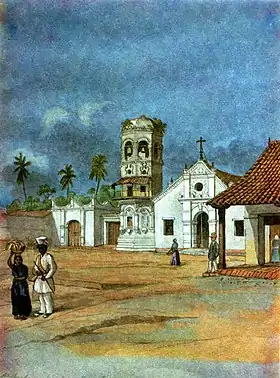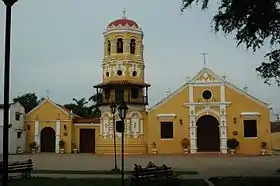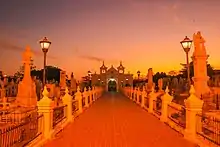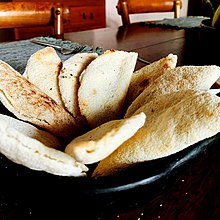Santa Cruz de Mompox
Mompox or Mompós, officially Santa Cruz de Mompox, is a town and municipality in northern Colombia, in the Bolívar Department, which has preserved its colonial character. Mompox depends upon tourism, fishing, and some commerce generated by the local cattle raising. It has about 30,000 inhabitants, and is adjacent to the municipalities of Pinillos and San Fernando.
Santa Cruz de Mompox | |
|---|---|
Municipality | |
 View of Mompox from the Magdalena River | |
 Flag  Seal | |
 Municipality and town of Mompox in the Bolivar Department. | |
| Country | |
| Region | Caribbean Region |
| Department | Bolivar Department |
| Foundation | 3 May 1537 |
| Founded by | Alonso de Heredia |
| Government | |
| • Mayor | Nubia Isabel Quevedo Ángel (2016-2019) |
| Area | |
| • Municipality | 645.37 km2 (249.18 sq mi) |
| Elevation | 33 m (108 ft) |
| Population (2015) | |
| • Municipality | 44,124 |
| • Density | 68/km2 (180/sq mi) |
| • Urban | 25,785 |
| Time zone | UTC-5 (Colombia Standard Time) |
| Website | Official website |
| Official name | Historic Centre of Santa Cruz de Mompox |
| Criteria | Cultural: (iv)(v) |
| Reference | 742 |
| Inscription | 1995 (19th session) |
Simón Bolívar, liberator of much of Spanish South America, said: "If to Caracas I owe my life, then to Mompox I owe my glory." Simón Bolívar arrived in Mompox in 1812 and recruited nearly all of the able-bodied men, some four hundred, who formed the basis of the army for his victory in Caracas.
History
Mampo (or Mompoj) was the local indigenous chieftain of the Malibu culture, when the Spanish conquistadors arrived, and Mompox means "land of the ruler Mampo". The city was founded on May 3, 1537, by Alonso de Heredia, brother of Pedro de Heredia, as a safe port on the Magdalena.[1] Santa Cruz de Mompox became quite prosperous as a port for the transportation of goods upriver into the interior. A royal mint was established here and the town was known for its goldsmiths. This prosperity had begun to wane in the nineteenth century, but continued until early in the twentieth century when the river shifted and sediment accumulated on this arm of the river, at which point Magangué became the favored port.
How to reach Mompox

- By air: The District of Mompox is served by the San Bernardo de Mompóx airport. Located in the outskirts of the city and near the urban center, it is easily accessible from anywhere in this World Heritage Site. In addition to the Mompóx Festijazz, Holy Week is when the Mompox airport will be the busiest as the sacred celebrations rank second in importance only to those in Popayán.
- By land: Starting from Carmen de Bolívar, take a bus at the Transversal de los Contenedores (known today as Ruta del Sol III) which will detour at the La Gloria, Magdalena township, passing also through Santa Ana and Talaiga Nuevo before finally reaching the urban center at the city of Mompóx.
Across the Reconciliación bridge, a mega-structure that extends for about 12 kilometers (7.4 miles) over the Magdalena river inaugurated on 30 March 2020. The Yati-Bodega segment connects the western and Magdalena Medio highways, both of which are part of the Ruta del Sol. This segment reduces travel time between the inner country and the Colombian Caribbean coast by approximately 3 hours, and touches the economy of both Mompox and La Mojana.
The structure comprises the Santa Lucia and Roncador bridges, the Isla Grande highway, a road to connect the Roncador and Bodega bridges, and maintenance between the Yatí pathway and Santa Fe.[2]
- By water: The main waterway to access the District of Mompóx is the Mompóx tributary of the Magdalena river. Mompox has a river terminal linked to the old river port that welcomes vessels from Magangué, El Banco, Santa Ana, and Barrancabermeja.
Buildings and architecture

Santa Cruz de Mompox is known for the preservation of its colonial architectural features, as expressed by the mixture of its Spanish and Indian styles. UNESCO named the historic center of Mompox as a World Heritage Site in 1995. Today, most of the colonial buildings are still used for their original purposes, which provides an excellent example of a Spanish colonial city. Of particular note is the wrought ironwork decorating doors, railings, and window grills along the streets, notably on Calle de la Albarrada, Calle Real del Medio, and Calle de Atrás. Notable churches include Santa Bárbara (built 1613), San Agustín (built 1606), San Juan de Dios, and Immaculate Conception. There is also a museum of colonial art that houses religious gold colonial masterpieces.
- The San Francisco Church was originally built in 1564 and the convent was founded in 1580 by Fray Francisco Gonzaga. The church is known for its handsome mural which was unfortunately damaged during reconstruction work in 1996. Since then the foundations have been reinforced and restoration is, for the time being, complete.
- San Juan de Dios Hospital was founded in 1550. In 1663 La Orden de todos los Hermanos Hospitalarios (The Knights Hospitaller) took over its management. It depended on the donations of the powerful families in the region and the royal tax charged on shipping along the Magdalena River for its maintenance and operation. San Juan de Dios is considered to be the oldest hospital in America still functioning in its original building.
- The House of the Apostles located on Calle Real del Medio was the mansion of a local shipping family and is visited by tourists to see the handsome images of the twelve apostles and of Jesus at the Last Supper.
- City Hall contained the colonial dungeons and the mayor's reception room. It was here that on August 6, 1810, the Act of Independence from Spain was signed, and the cry "Ser Libres o Morir" ("Freedom or Death") was first heard.
- The Municipal Palace, also known as the Cloister of San Carlos, was built in 1660. This cloister housed the city's first secondary school until the Jesuits were driven out. It ceased to be a convent in 1767. Here in 1809 the Universal School of Saint Peter the Apostle was founded by Pedro Martínez de Pinillos.
- The Church of the Immaculate Conception was originally built of adobe by Pedro de Heredia in 1541. Ten years later it was enlarged and masonry replaced much of the adobe, and the straw roof was replaced with tile. Because of its large size, it was often regarded as the cathedral of Mompox. Over the years, the original building was restored several times, with the last restoration completed in 1795. In 1839 the Governor of the Province ordered its demolition and the present church was built on the site.
- The Santa Bárbara Church is one of the best-known and most important churches in the city. Completed in 1613, the church has a baroque bell tower with a balcony. It is decorated with moldings of palm trees, flowers, and lions. The tower's dome is equally baroque, and the church's three altars are heavily gilded.

- The Mompox farmer's market was built at the turn of the 20th century as a way to organize vendors of fruits, vegetables, meats, fish, and other kinds of merchandise who until then would simply claim a spot in the street.
The building visually disrupts the landscape between the Church of the Immaculate Conception and the Magdalena river. Thus, the building represents a modification of the original design of the town square.[3]

- The Cemetery's construction in 1829. The chapel and altar were built in 1846. Before this, it was common in colonial times to bury the dead in secluded spaces inside churches, which led to complaints from the population.[4]

Tourism
From the moment it was declared a UNESCO World Heritage Site, Mompox has been attractive for tourists due to its colonial architecture. This has made it the stage for important independent cinema festivals and the Jazz Festival.

Another reason why Mompox is popular among visitors is the Holy Week celebrations starting on Palm Sunday with a flower and candles parade to honor the dead followed by various other ceremonies associated with diverse religious events.[5]
All this, as well as its complex of ecclesiastical locales make Mompox a prime destination for religious tourism in Colombia.
There is a close relationship between Mompox and the Magdalena river which defined its origin, its flourishing, and its early eclipse.
[6] Another reason to visit Mompox is its gastronomy, featuring myriad dishes based on cassava, corn, fish, achiote, and chili pepper.[7]
One of the biggest crowd-pleasers is the casabito, an ubiquitous street dish consisting of an omelet prepared with raw cassava, cheese, ground coconut, sugar, and, in some cases, anise.
Another renowned delicacy is the queso de capa: a type of cheese with over 100 years of artisanal production and tradition, it features an elastic texture and is served in layers [8]

Music
Mompox is the home of the musician/singer Totó la Momposina and her band. Their music is a fusion of African and Spanish influences as well as the harmonies of the natives of the region and is associated with cumbia music.
Mompox Filigree
A few artisan guilds took hold in Mompox during the 16th century, including clay workers, blacksmiths, goldsmiths, and silversmiths. At the same time, the port was an important trade center for gold extracted in Antioquia, which left behind numerous pieces of the precious metal for local commercialization.
These two factors converged on the dissemination of the filigree craft.[9]
The indigenous casting technique, which is at the heart of the craft of the local goldsmiths, was combined with the ancestral techniques brought by African slaves, thus giving birth to Mompox filigree. This form of art is defined by the union of different thin threads of metal which are then intertwined to create different kinds of ornaments with spirals as the most predominant shapes.
Due to current elevated gold prices in both local and international markets, artisans have developed techniques to replace gold with silver.[10]
References
- (in Spanish) Fundaciones de ciudades y poblaciones - Banco de la República
- "Fondo de Adaptación, entrega al INVÍAS la Interconexión Vial "Yatí – La Bodega" en Bolívar para ser puesta en operación". Retrieved January 8, 2021.
- Téllez, Germán. (1995). La arquitectura colonial de Santa Cruz de Mompox (1. ed.). Bogotá: El Ancora Editores. ISBN 958-36-0020-2. OCLC 34943417.
- Santa Cruz de Mompox, Colombia. Téllez, Germán., Instituto Colombiano de Cultura. Bogotá, Colombia: Ediciones PROA. 1994. ISBN 958-9054-32-3. OCLC 38032621.CS1 maint: others (link)
- "Pueblos Patrimonio en Colombia: Mompox". Marca País Colombia (in Spanish). 2018-08-20. Retrieved 2021-01-09.
- Woods, Sarah, 1967-. Colombia. Bradt Travel Guides, (Third ed.). Chalfont St. Peter. ISBN 978-1-84162-921-6. OCLC 906658467.CS1 maint: extra punctuation (link) CS1 maint: multiple names: authors list (link)
- "Sabores y Saberes" (PDF). 9-01-20. Check date values in:
|date=(help) - "Turismo". www.santacruzdemompos-bolivar.gov.co (in Spanish). Retrieved 2021-01-09.
- Botero, María Mercedes. (2007). La ruta del oro : una economía primaria exportadora : Antioquia, 1850-1890 (1. ed.). Medellín: Fondo Editorial Universidad EAFIT. ISBN 958-8281-81-4. OCLC 191078673.
- Falchetti, Ana Maria,. Lo humano y lo divino : metalurgia y cosmogonía en la América antigua. Universidad de los Andes (Bogotá, Colombia). Facultad de Ciencias Sociales,, Instituto Colombiano de Antropología e Historia, (Primera edición ed.). Bogotá, D.C., Colombia. ISBN 978-958-8852-54-6. OCLC 1048899719.CS1 maint: extra punctuation (link) CS1 maint: multiple names: authors list (link)
External links
| Wikimedia Commons has media related to Santa Cruz de Mompox. |